|
|
|
Sort Order |
|
|
|
Items / Page
|
|
|
|
|
|
|
| Srl | Item |
| 1 |
ID:
169306


|
|
|
|
|
| Summary/Abstract |
This article deals with the possibilities and challenges of Japan's dual-use space situational awareness (SSA) systems. Japan is unique in a way that military use of outer space was completely prohibited for almost 40 years until the Basic Space Act (2008) became effective. The change in its space policy was decided because of the rapidly worsening security environment in East Asia, accompanied by preeminent threats to the safety, stability and sustainable use of outer space that constitutes a prerequisite for the safety and welfare of any country. This has led Japan to begin developing a full-scale SSA operation. However, Japan's long-standing non-military practice forces it to design and develop its SSA systems in a different manner than other advanced spacefaring nations. Given such conditions/restrictions, this article first identifies a Japanese means of constructing full-scale dual-use SSA systems, particularly taking into account the functions and capabilities of the Japan Aerospace Exploration Agency (JAXA), the significance of the Japan-U.S. Alliance and a series of recent governmental decisions. The merits and challenges of Japan's whole-of-government construction of the dual-use SSA will then be explored; this involves difficult processes to coordinate different defense and civil mission requirements. The conclusion envisions a balance between the Japan Air Self Defense Force's superior air defense capability and JAXA's accumulated technical capabilities, which together would enable full-fledged defense space utilization starting with the SSA.
|
|
|
|
|
|
|
|
|
|
|
|
|
|
|
|
| 2 |
ID:
173121


|
|
|
|
|
| Summary/Abstract |
Drawing upon 106,181 patent applications by the world’s largest defense firms and 241,571 patent citations (2002–2011), this article has two main objectives. The first is to explore the factors affecting the production of mixed patents (those with potential dual applications in both military and civilian spheres). The second is to identify the causes of the use of military knowledge for civilian inventions (spin-off) and the use of civilian knowledge in military patented technologies (spin-in). Our calculations show highly significant coefficients for the variables capturing the “military technological capability” and the size of the company in explaining the production of mixed technologies. The spin-off process is affected by the military technological capability, the size of the firm, and the location. The spin-in mechanism is explained by the military technological capability and the location of the firm, while the size of the company is not relevant.
|
|
|
|
|
|
|
|
|
|
|
|
|
|
|
|
| 3 |
ID:
069862
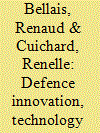

|
|
|
| 4 |
ID:
179276
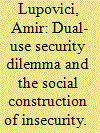

|
|
|
|
|
| Summary/Abstract |
In this article I introduce the concept of the “dual-use security dilemma,” specifically through elaborating on two main aspects that shape this dilemma. First, inspired by traditional security scholarship, I focus on the spiral dynamics of actors responding to the insecurities raised by dual-use technologies that affect this type of dilemma. Second, I further develop a securitization reading of the traditional security dilemma, tracing how social constructions of insecurities and the justification of extraordinary measures affect the dynamics of the security dilemma. Combining these two aspects, I suggest that enunciators shape the dynamics of the dual-use security dilemma by using specific rationales of insecurity to mobilize support for measures against opponents holding dual-use technologies, whose response further fuels insecurity that spirals over time. The innovative theoretical and policy implications of this research become especially important given the rise of dual-use cyber technologies.
|
|
|
|
|
|
|
|
|
|
|
|
|
|
|
|
| 5 |
ID:
147321
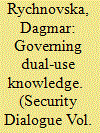

|
|
|
|
|
| Summary/Abstract |
Fears of malicious non-state actors and potentially dangerous research have given rise to new efforts to secure science against misuse. With the rapid advancements of science, what receives attention in security politics is how to oversee not only material and technology but also knowledge. This article explores the emerging security governance of knowledgeable practices in life sciences and critically reflects on its possible implications. The article first contextualizes the current understanding of the dual-use dilemma in life sciences in prior discourse on science–security relations and argues that security concerns have converged with ethical dilemmas related to the governing of science. Drawing on critical theory, security studies and science studies, it then conceptualizes dual use as a problem of organizing circulations and suggests that policing scientific knowledge through the establishment of a ‘culture of responsibility’ can be understood as a part of broader shifts towards the subjectification of knowledge. Using examples from life sciences, the article analyses how practices of knowledge production and circulation are adjusted to the logic of security. The article concludes that the converging political rationalities and governmental techniques of responsible science and security risk management, understood as an ‘ethicalization’ of security, affect the politicization of security expertise, prospects of resistance and the democratic accountability of science.
|
|
|
|
|
|
|
|
|
|
|
|
|
|
|
|
| 6 |
ID:
162680
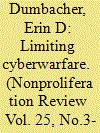

|
|
|
|
|
| Summary/Abstract |
An arms race in cyberspace is underway. US and Western government efforts to control this process have largely been limited to deterrence and norm development. This article examines an alternative policy option: arms control. To gauge whether arms-control models offer useful lessons for addressing cyber capabilities, this article compiles a new dataset of predominantly twentieth-century arms-control agreements. It also evaluates two case studies of negotiated agreements that regulate dual-use technologies, the 1928 Geneva Protocol prohibiting chemical- and biological-weapon use and the 1944 Chicago Convention on International Civil Aviation. The analysis underscores the limits of norm development for emerging technologies with both civilian and military applications. It finds lessons for developing verifiable, international cooperation mechanisms for cyberwarfare in the regulatory model of international aviation. Conventionally, arms-control agreements take advantage of transparent tests or estimates of arms. To restrict cyberwarfare activities, experts and policy makers must adapt arms-control models to a difficult-to-measure technology at an advanced stage of development and use. Further investigation of international regulatory schemes for dual-use technology of similar diffusion and development to the internet, such as international civil aviation, is needed.
|
|
|
|
|
|
|
|
|
|
|
|
|
|
|
|
| 7 |
ID:
169463
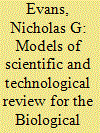

|
|
|
|
|
| Summary/Abstract |
Science and technology (S&T) review is key to anticipating developments in the life sciences that may benefit or run contrary to the aims of the 1972 Biological and Toxin Weapons Convention. It serves as a mechanism for both preparing against novel biological threats and identifying the best opportunities for developing and sharing the life sciences to the fullest extent. In the age of rapidly advancing biotechnology, S&T review needs to be wide ranging, involve a diverse set of inputs, and be transparent about its methods and data. This viewpoint considers four models of S&T review and their capacity to respond to the challenge of the life sciences: standing advisory boards; ad hoc working groups; peer review; and wikis. It then identifies a hybrid model that is suitably broad, diverse, and transparent.
|
|
|
|
|
|
|
|
|
|
|
|
|
|
|
|
| 8 |
ID:
182964
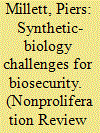

|
|
|
|
|
| Summary/Abstract |
Although synthetic biology and biological engineering are often portrayed as emerging disciplines, there is over a decade of experience in their interactions with biosecurity. The International Genetically Engineered Machine competition (iGEM) brings together nearly 6000 students on multidisciplinary teams to engineer biology following synthetic biology’s “design, build, test, and learn” cycle. During its fifteen-year existence, iGEM has been affected by biosecurity and in turn has affected it. This article describes four specific case studies at iGEM, highlighting their implications for biosecurity, and proposes ways to improve relevant biosecurity procedures and practices. It showcases how embracing engineering approaches and principles can help to structure efforts to strengthen biosecurity.
|
|
|
|
|
|
|
|
|
|
|
|
|
|
|
|
| 9 |
ID:
182956


|
|
|
|
|
| Summary/Abstract |
Between 1940 and the late 1950s, the United Kingdom had a limited biological program to provide a retaliatory capability should UK forces be attacked using biological warfare (BW). Aspects of BW defense have been investigated from 1940 up to the present day. Techniques, processes, and equipment used within biological research programs are recognized to have dual-use applications; aerobiology is one such dual-use area. Research during these offensive and defensive eras of the UK BW research program has contributed to aerobiological science, leading to a number of positive changes in some areas, including laboratory safety; understanding of infection by the aerosol route; and survival, detection, and identification of airborne pathogens. This article will discuss the historical contributions made to aerobiology science, the global contemporary legislation that governs dual-use research, and a modern case study based upon this type of investigation. The article will contribute to our understanding of the dual-use aspects of a BW program.
|
|
|
|
|
|
|
|
|
|
|
|
|
|
|
|
|
|
|
|
|